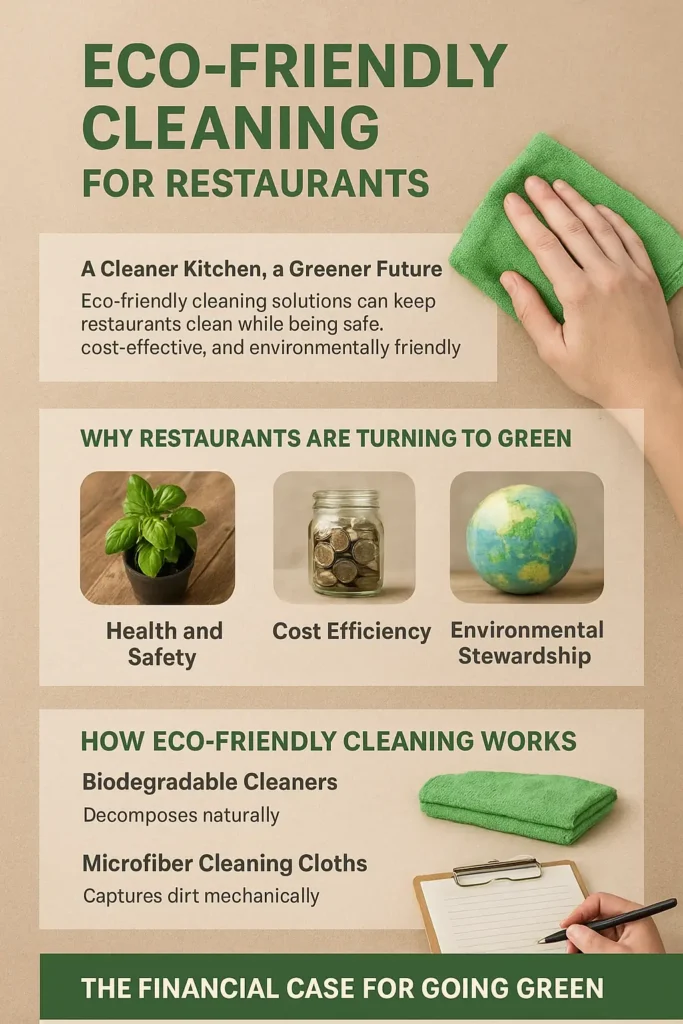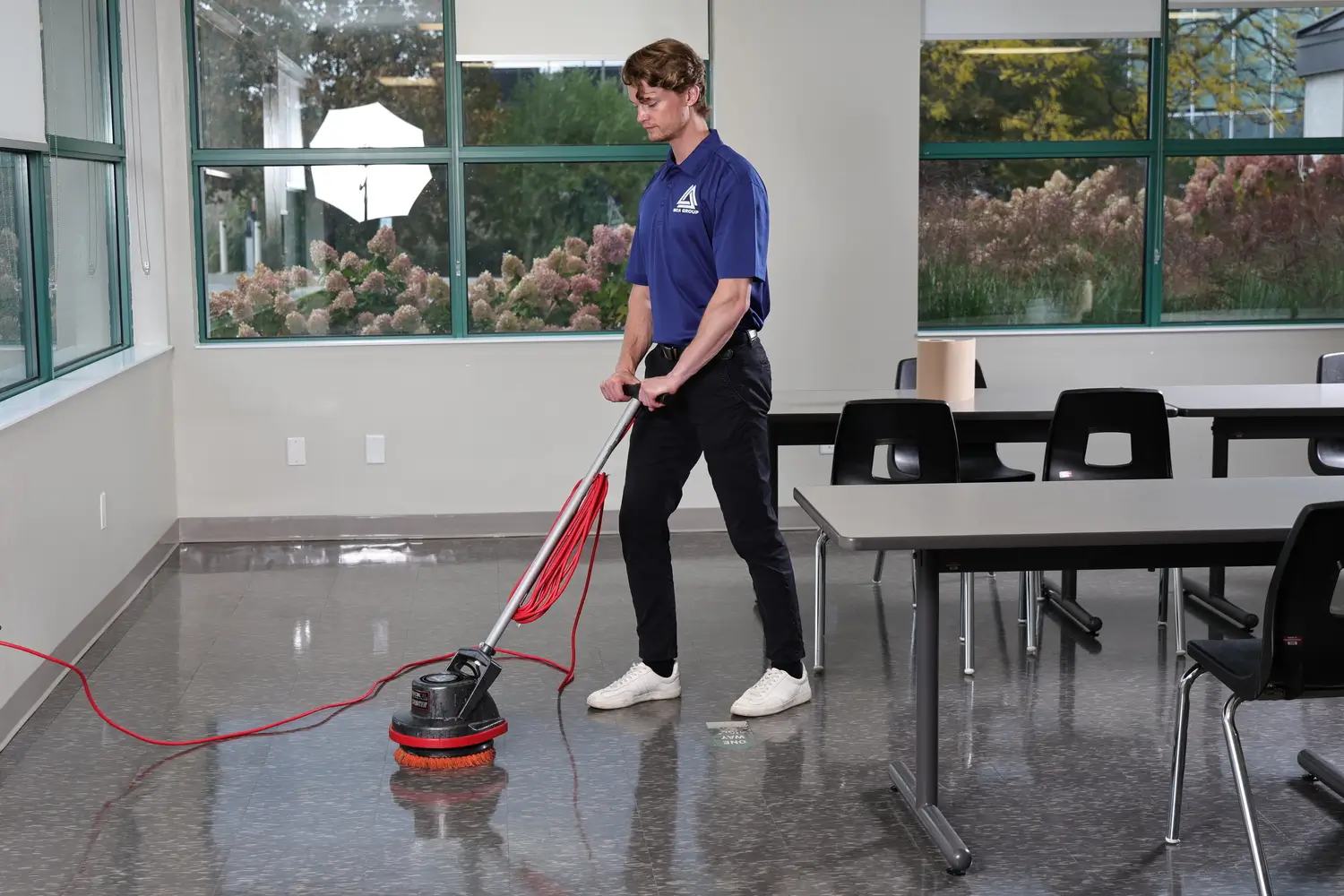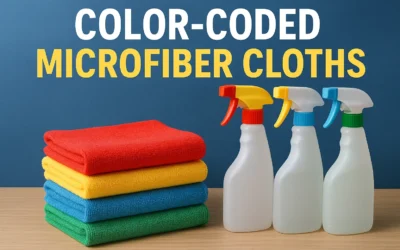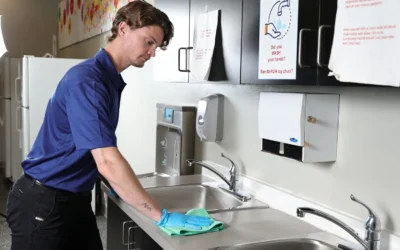A Cleaner Kitchen, a Greener Future
Running a restaurant means maintaining spotless hygiene — from the kitchen floor to the dining tables. But in the push for cleanliness, many establishments rely on harsh chemical cleaners that harm not only the environment but also staff health and budgets.
The good news? Sustainable, eco-friendly cleaning solutions can keep your restaurant just as clean, while being safer for people, cheaper in the long run, and kinder to the planet. In this guide, we’ll explore how restaurants can transition to green cleaning without sacrificing performance or compliance.
Why Restaurants Are Turning to Green Cleaning
The shift toward eco-friendly cleaning isn’t just a trend — it’s a business transformation rooted in responsibility and innovation. Modern restaurant owners are recognizing three major benefits:
- Health and Safety:
Eco-cleaners reduce exposure to toxic residues and volatile organic compounds (VOCs) that can cause respiratory issues, skin irritation, and allergic reactions. Using plant-based disinfectants and biodegradable degreasers creates a safer environment for kitchen staff and customers alike. - Cost Efficiency:
While sustainable cleaning products sometimes cost more upfront, they last longer and reduce long-term expenses. Concentrated solutions, refillable systems, and reduced waste disposal fees help restaurants save money over time. - Environmental Stewardship:
Restaurants generate significant waste and water use daily. Switching to biodegradable cleaners minimizes chemical runoff into water systems and supports your brand’s sustainability goals — a growing priority for eco-conscious diners.
How Eco-Friendly Cleaning Works
At its core, green cleaning replaces harsh chemical compounds with biodegradable, non-toxic, plant-based ingredients. These cleaners use enzymes and natural surfactants to break down grease, grime, and bacteria effectively — without leaving harmful residues.

Key Elements of a Green Cleaning Program
- Biodegradable Cleaners: Formulas that decompose naturally and leave no microplastic or toxic residue.
- Microfiber Cleaning Cloths: Reduce chemical use by capturing more dirt mechanically.
- Energy-Efficient Equipment: Steam cleaners and low-water-use dishwashers reduce resource consumption.
- Proper Waste Management: Recycling packaging, reusing spray bottles, and safely disposing of greywater.
This integrated approach not only improves cleanliness but also boosts your restaurant’s semantic connection to sustainability — an idea that resonates deeply with both customers and search engines.
From Chemical to Conscious: The Transition Process
Switching to eco-friendly cleaning practices can seem daunting, but it doesn’t need to be. With a structured plan, your restaurant can move toward sustainability smoothly and cost-effectively.
1. Audit Current Cleaning Practices
Start by assessing your existing cleaning supplies, usage rates, and disposal habits. Identify which chemicals pose the highest health or environmental risks — such as bleach, ammonia, or petroleum-based detergents.
2. Choose Certified Green Products
Look for cleaners with recognized certifications, such as:
- EPA Safer Choice
- Green Seal
- EcoLogo
- EU Ecolabel
These certifications ensure that products meet rigorous environmental and safety standards.
3. Train Staff
Effective implementation depends on awareness. Educate your cleaning staff and kitchen team about proper dilution, application, and disposal methods. Reinforcing new habits ensures consistent performance and cost savings.
4. Redesign Cleaning Schedules
Eco-cleaners often require slightly longer dwell times for disinfection. Adjust cleaning schedules to maintain health-code compliance without unnecessary chemical exposure.
5. Track Results
Monitor both financial and environmental impact. You may find that reduced chemical consumption and lower packaging waste translate to measurable savings and stronger brand reputation.
The Financial Case for Going Green
Beyond environmental goodwill, sustainable cleaning is economically smart. Restaurants that switch to concentrated, refillable eco-products report significant reductions in waste management costs and inventory turnover.
Example Savings Opportunities
- Bulk Purchasing: Larger quantities of concentrated green solutions reduce per-use costs.
- Reduced PPE Needs: Non-toxic formulas lessen the need for specialized gloves and masks.
- Lower Equipment Wear: Harsh chemicals can corrode surfaces and appliances; eco-alternatives extend lifespan.
- Marketing Leverage: Promoting your green initiatives attracts eco-conscious customers — a growing market segment.
When viewed holistically, eco-friendly cleaning doesn’t just reduce expenses; it becomes a competitive advantage and a core element of brand storytelling.
Eco-Friendly Cleaning and Compliance
Restaurants operate under strict health and safety regulations. The misconception that “green” means “less effective” is outdated. Many eco-certified cleaners now meet or exceed sanitization requirements for foodservice environments.
Compliance Benefits
- Meets FDA food-contact surface guidelines.
- Aligns with local sustainability ordinances and waste reduction goals.
- Reduces risk of chemical exposure incidents — a major liability consideration.
By aligning compliance with sustainability, your restaurant demonstrates that responsible operations and hygiene excellence can coexist seamlessly.
Building a Sustainable Brand Through Cleanliness
Customers today expect transparency and sustainability from the brands they support. When diners see that your restaurant uses biodegradable products and avoids harsh chemicals, it signals care — not just for food quality but for community well-being.
Here are ways to communicate your green cleaning efforts:
- Highlight eco-cleaning certifications on menus or websites.
- Share sustainability milestones on social media.
- Involve staff in “green week” campaigns to reinforce internal buy-in.
These actions turn eco-cleaning from a back-of-house initiative into a visible part of your brand’s identity and narrative.
The Future of Cleaning in Foodservice
The restaurant industry’s next evolution isn’t just about culinary innovation — it’s about sustainable operations. As AI-driven sanitation systems and smart dosing technology emerge, eco-friendly cleaning will become the new standard for efficiency and environmental care.
By embracing sustainable cleaning now, your restaurant can:
- Future-proof compliance with evolving regulations.
- Strengthen employee well-being and retention.
- Build lasting customer trust through transparent, ethical operations.
Conclusion: Sustainability That Pays Off
Eco-friendly cleaning isn’t an expense — it’s an investment in your restaurant’s longevity, brand equity, and the planet’s health. By adopting safer, greener cleaning solutions, you ensure your restaurant stays spotless, compliant, and ahead of consumer expectations.
Cleaner tables. Healthier kitchens. A greener tomorrow.
That’s what modern hospitality looks like.





